- Home
- »
- Reports
- »
-
Employee Relocation Procurement Intelligence Report, 2030
![Employee Relocation Procurement Intelligence Report, 2030]()
Employee Relocation Procurement Intelligence Report, 2023 - 2030 (Revenue Forecast, Supplier Ranking & Matrix, Emerging Technologies, Pricing Models, Cost Structure, Engagement & Operating Model, Competitive Landscape)
- Published Date: Oct, 2023
- Base Year for Estimate: 2022
- Report ID: GVR-P-10550
- Format: Electronic (PDF)
- Historical Data: 2020 - 2021
- Number of Pages: 60
Employee Relocation Category Overview
“The shift in dynamics of relocating talent is accelerating the growth of employee relocation category’s growth.”
The employee relocation category is expected to grow at a CAGR of 1.2% from 2023 to 2030. The pandemic has revolutionized the way corporate offices work. Companies are moving to hybrid work or remote work models. The surge in remote work is causing a notable influence on category dynamics. Previously, organizations usually mandated employees to move to a particular site for job roles. Yet, as remote work gains prevalence, employees have the newfound ability to work from any global location. This shift provides employees with enhanced autonomy and adaptability, while simultaneously simplifying the process for companies to allure and maintain top-tier professionals from around the world.
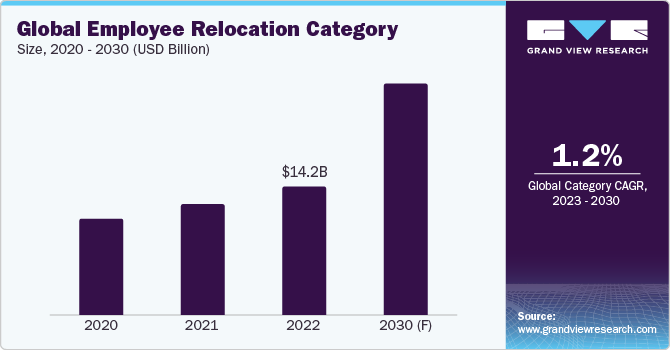
Additionally, technological advancement such as virtual reality (VR), augmented reality (AR), and artificial intelligence (AI) has also transformed the employee relocation process. Although VR has been extensively utilized in employee training and developmental programs, certain enterprises are now exploring methods to integrate VR technology into the process of relocation. For instance, the prevalent use of 360-degree cameras, seamlessly compatible with VR headsets, offers an ideal solution for presenting properties in full detail, regardless of location or time. Presenting a panoramic view of a novel residence, workplace, or city through VR closely simulates reality. When employees are introduced to their new surroundings using VR, it might foster more profound emotional connections, thereby enhancing their dedication to the relocation endeavor.
The pace of AI advancements is moving remarkably fast, by the rapid development of chatbots. These chatbots have transitioned from performing basic tasks to efficiently managing substantial volumes of data within a system. This transformation positions them as highly valuable collaborators in the process of relocation. To illustrate, chatbots can now autonomously generate cost-of-living estimates and collect essential information through user-friendly questionnaires. This stands in stark contrast to the cumbersome procedures involving countless forms and emails from the past. Additionally, chatbots offer round-the-clock availability, providing reassurance to relocating employees by promptly addressing their inquiries.
The global employee relocation category size was estimated at USD 14.2 billion in 2022. In August 2023, Workia a startup backed by Equus Software developed Software-as-a-service (SaaS) designed to ease global employee mobility management. Unlike the conventional method that involves using spreadsheets and files stored locally, the tool revolutionizes this process by offering a centralized, secure, and intuitive platform.
Virtual consultations have now solidified their position as a fundamental technological resource within most relocation management firms. Activities associated with moving that traditionally required in-person engagement with external entities, such as assessing household items, could currently be conducted through virtual means. This transition to virtual procedures not only offers cost advantages to employers but also enhances the convenience of relocating individuals, enabling them to fulfill requirements at their preferred schedule and speed.
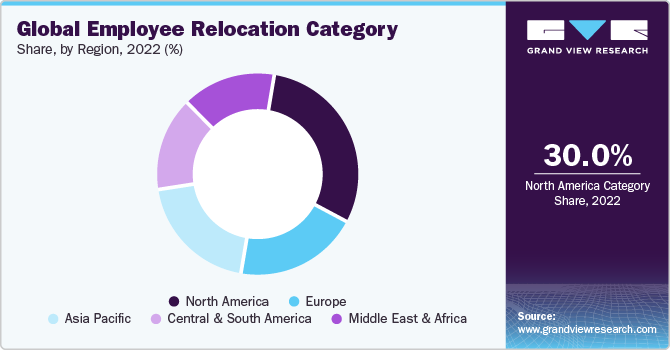
When employed efficiently, cutting-edge technology can reduce expenses associated with moving the staff from one place to another. It can act as an alternative to conventional preliminary visits, which involve costly airfare, accommodations, and other incidental charges. Furthermore, these tools have the added benefit of streamlining the guidance provided to the relocating employee and minimizing the need for excessive human involvement.
Supplier Intelligence
“What are the characteristics of the employee relocation category?”
The global employee relocation category is fragmented. The category encompasses a wide range of offerings, including home sale assistance, temporary housing, visa and immigration support, language training, cultural orientation, and more. Different companies may specialize in different aspects of relocation, leading to a diverse market landscape.
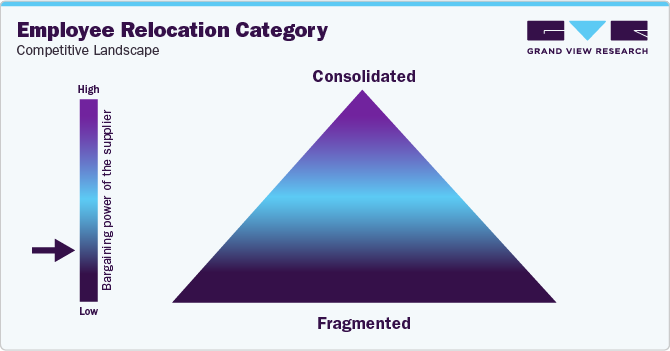
While the suppliers require expertise in managing various aspects of employee relocation, including legal, logistical, and cultural considerations, the barriers to entry could be relatively high due to the need for significant investments in technology, network development, regulatory compliance, and industry knowledge. Established players may have economies of scale and experience that deter new entrants.
Key suppliers covered in the category:
-
Signature Relocation
-
Aires
-
Graebel Companies
-
NRI Relocation
-
WHR Global Employee Relocation
-
Cartus Corporation
-
Altair Global
-
Sirva Worldwide
-
Atlas Van Lines
-
Allied Van Lines
Pricing and Cost Intelligence
“What are some of the major cost components in employee relocation? How are these components impacting the category?”
Labor costs, packing/unpacking services, transportation, temporary housing, taxes, and others are some of the cost components involved in relocating an employee. On average, the relocation package can cost from USD 19,000 to USD 24,000 for renters, and for homeowners, it may cost between USD 72,000 to 97,000. Although the final cost of moving may vary. For an approximate example, for a current employee who is a homeowner can cost USD 97,166, and for a current employee who is a renter can cost 24,216 USD. Similarly, for a new hire who is a homeowner, relocating can cost USD 72,627, and if the new hire is a renter, it may cost around USD 19,309. Companies are increasing their budget to call employees back to the office. They are offering onboarding bonuses to new hires to cover the relocation of an employee. Whereas for current employees it becomes difficult to adjust, the pay/salary to cover relocation expenses which may result in high relocation costs for current employees.
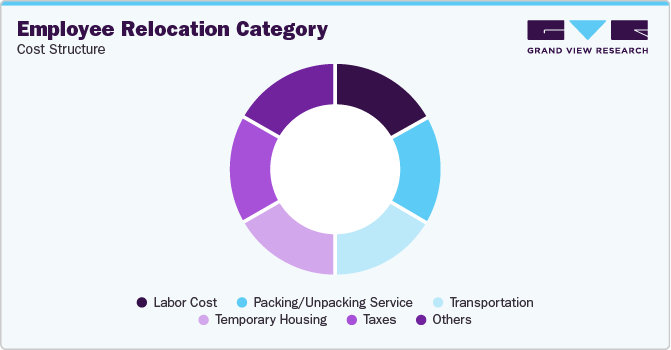
There are various relocation packages offered by the companies such as lump sum packages, direct billing, reimbursement, third-party relocation, and expatriation assistance. For instance, a lump sum package covers expenses such as transportation, moving company expenses, temporary rental homes, security deposits, fuel, purchasing a new home, and other expenses. The company provides employees with a lump sum amount that is required to pay for their relocation wherever that may be.
The following table below indicates the rate table of moving household goods.
Moving Household Goods Commuted Rate Table (Example)
Miles
Cost Per 100 Pounds (CWT)
1 to 500
USD 159.03
501 to 1,000
USD 179.83
1,001 to 1,500
USD 191.82
1,501 to 2,000
USD 201.55
2,001 to 2,500
USD 216.58
Above 2,500
USD 222.28
The expatriation assistance relocation package pertains to staff members relocating to company sites in foreign countries. Within this form of relocation package, employers go beyond covering mere moving and transportation expenses. They extend support by aiding employees in securing work visas, offering funded journeys to the new work site for housing exploration before the move, and potentially facilitating cultural assimilation for the relocated employees.
The report provides a detailed analysis of the cost structure of employee relocation and the pricing models adopted by prominent suppliers in this category.
Sourcing Intelligence
“What are some of the best sourcing practices considered for employee relocation?”
North America is the major region that dominated the category in 2022. Employee relocation is on the rise owing to opportunities in the U.S. According to Zippia’s 2023 report, around 56% of Americans are positive toward job relocation. Additionally, around 64% of the employees who moved for work received transfer packages. Moreover, the staff relocating business is also on the rise, which registered an increase of 2.5% in 2023 as compared to 2022 according to the IBIS world report.
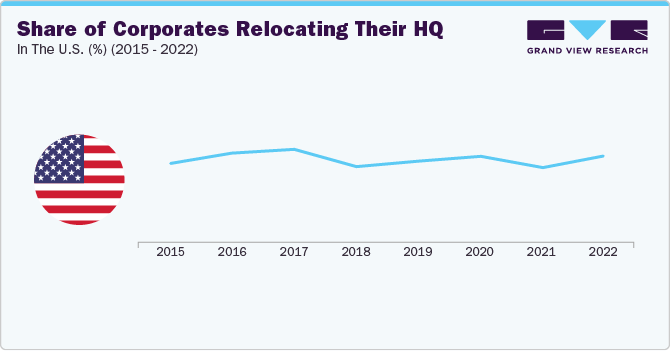
The UK is the most expensive country for employee relocation. In 2022, annual pay and benefits for an expatriate cost a business an average of USD 486,243, which was an increase of around 11% as compared to the previous year. The increase was witnessed due to the rising cost of various benefits such as accommodations, travel expenses, and others.
Italy on the other hand is expected to emerge as a competitive location for staff relocation owing to lower taxes. According to ftn news, in 2023, the total cost of sending a middle manager to Italy grew by only 1%, despite of 4% increase in salaries, and a 7% rise in benefits cost as compared to the previous year.
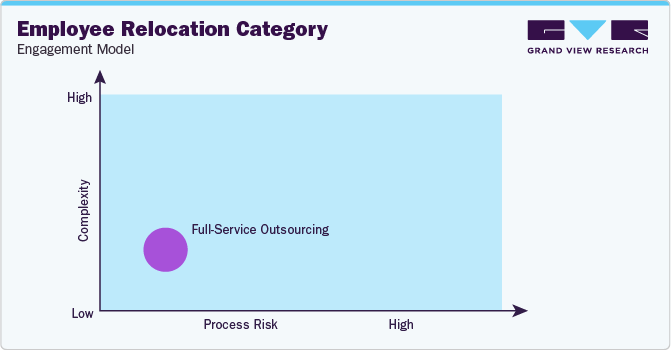
“The full services outsourcing model envisages the client outsourcing the complete operations/manufacturing to single or multiple companies”
In terms of employee relocation sourcing intelligence, it is beneficial to outsource the relocating service as it helps in solving problems related to tax, and legal considerations. Opting for outsourced moving services has the potential to consolidate communication and decision-making through a single service provider, which helps to ease the relocating process for the clients. Additionally, outsourcing can enhance communication with employees undergoing relocation by providing them with a solitary focal point for coordination. This approach eradicates redundant communication and minimizes duplicated efforts.
An approved provider model is the most common form of the operating model due to its potential for higher value creation. In this model, the category service provider must follow guidelines stated in Employee Relocation Policy 101, which outlines the logistical procedures, and financial benefits needed to move an employee from one place to another. The policy helps service providers comply with legal factors such as legal entity creation, immigration, tax compliance, and contracts/agreements.
The report also provides details regarding day one, quick wins, portfolio analysis, key negotiation strategies of key suppliers, and low-cost/best-cost sourcing analysis.
Employee Relocation Procurement Intelligence Report Scope
Report Attribute
Details
Employee Relocation Category Growth Rate
CAGR of 1.2% from 2023 to 2030
Base Year for Estimation
2022
Pricing Growth Outlook
2% - 3% (Annually)
Pricing Models
Lump sum pricing, direct billing pricing, reimbursement pricing, third-party pricing, competition-based pricing
Supplier Selection Scope
End-to-end service, customization offered, cost and pricing, compliance, service reliability, and scalability
Supplier Selection Criteria
Relocation packages available, global reach, customization option, services offered, technology and tools used, track record and reputation, regulatory compliance, and others
Report Coverage
Revenue forecast, supplier ranking, supplier positioning matrix, emerging technology, pricing models, cost structure, competitive landscape, growth factors, trends, engagement, and operating model
Key Companies Profiled
Signature Relocation, Aires, Graebel Companies, NRI Relocation, WHR Global Employee Relocation, Cartus Corporation, Altair Global, Sirva Worldwide, Atlas Van Lines, Allied Van Lines.
Regional Scope
Global
Historical Data
2020 - 2021
Revenue Forecast in 2030
USD 15.6 billion
Quantitative Units
Revenue in USD billion and CAGR from 2023 to 2030
Customization Scope
Up to 48 hours of customization free with every report.
Pricing and Purchase Options
Avail customized purchase options to meet your exact research needs. Explore purchase options
Frequently Asked Questions About This Report
b. The global employee relocation category size was valued at approximately USD 14.2 billion in 2022 and is estimated to witness a CAGR of 1.2% from 2023 to 2030.
b. Globalization of businesses and job opportunities, the pursuit of better work-life balance, and the need for specialized talent in various geographic locations are driving the growth of the category.
b. According to the LCC/BCC sourcing analysis Mexico, Thailand, and South Africa are the ideal destinations for sourcing employee relocation services.
b. This category is fragmented with the presence of numerous players competing for market share. Some of the key players are Signature Relocation, Aires, Graebel Companies, NRI Relocation, WHR Global Employee Relocation, Cartus Corporation, Altair Global, Sirva Worldwide, Atlas Van Lines, Allied Van Lines.
b. Labor costs, packing/unpacking services, transportation, temporary housing, taxes, and others are some of the key cost components of this category.
b. Research on relocation service providers, look for service providers that offer customization, service providers that cover all the expenses, global presence, transparency in pricing, and communication with the relocating employee are some of the best practices.
Share this report with your colleague or friend.
GET A FREE SAMPLE
This FREE sample includes market data points, ranging from trend analyses to market estimates & forecasts. See for yourself...
Add-on Services
Should Cost Analysis
Component wise cost break down for better negotiation for the client, highlights the key cost drivers in the market with future price fluctuation for different materials (e.g.: steel, aluminum, etc.) used in the production process
Rate Benchmarking
Offering cost transparency for different products / services procured by the client. A typical report involves 2-3 case scenarios helping clients to select the best suited engagement with the supplier
Salary Benchmarking
Determining and forecasting salaries for specific skill set labor to make decision on outsourcing vs in-house.
Supplier Newsletter
A typical newsletter study by capturing latest information for specific suppliers related to: M&As, technological innovations, expansion, litigations, bankruptcy etc.
![gvr icn]()
NEED A CUSTOM REPORT?
We can customize every report - free of charge - including purchasing stand-alone sections or country-level reports, as well as offer affordable discounts for start-ups & universities.
Contact us now to get our best pricing.
![esomar icon]()
ESOMAR certified & member
![ISO]()
ISO Certified
We are GDPR and CCPA compliant! Your transaction & personal information is safe and secure. For more details, please read our privacy policy.
We are committed towards customer satisfaction, and quality service.
Client Testimonials

"The quality of research they have done for us has been excellent..."
ISO Certified


